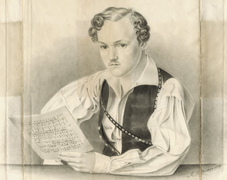"Zampa" by Hérold @ RISM
Monday, June 3, 2013

Ferdinand Hérold (1791-1833) was a composer of Alsatian descent. He received his first music lessons from his father Franz Joseph, who had settled in Paris in 1781 to teach piano. When he was around 16, Hérold was accepted to the Paris Conservatory and joined Etienne-Nicolas Méhul’s piano class beginning in 1811. Hérold won the Prix de Rome and traveled to Italy at the end of 1812. He composed one opera for Naples and did not return to Paris until 1815, where he worked as maestro al cembalo at the Théâtre Italien. In the years that followed, he received various opera commissions but did not have his first public success until 1826 with Marie, whereupon he transferred to the Paris Opéra as premier chef de chant. Several ballets followed until Hérold produced his masterpiece Zampa ou la fiancée de marbre (Zampa, or the Marble Bride; libretto by Anne-Honoré Joseph Duveyrier) in 1831. Sadly, two years after this success, Hérold succumbed to tuberculosis.
In addition to Zampa, his ballet La fille mal gardée (1828) is one of Hérold’s best-known works. The three-act Zampa became one of the most popular comic operas of the 19th century. This can also be seen from the numerous sources found in the RISM online catalog. The world premiere on 3 May 1831 at the Paris Opéra Comique was followed by around 500 performances until 1877. In the same year as the premiere, Schott’s Söhne published a version in German and French by Carl Blum (1786-1844), revealing the popularity of the work in Germany as well. More recently, the Stadttheater in Gießen, Germany performed the work in 2005 and in 2008 there was a new production of it at the Opéra Comique in Paris under the direction of William Christie.
Synopsis of Zampa:
In a castle in Sicily, Alphonse de Monza and his fiancée Camille are about to get married. As they await her father, the wealthy merchant Lugano, Camille sings the ballad of Alice Manfredi, who was betrayed by her lover and of whom a marble statue stands in the castle. A stranger arrives: Zampa, a pirate who is being sought by the authorities. He is actually the Count of Monza, Alphonse’s older brother and the one who seduced Alice. Zampa reveals his identity only to Camille. He has taken her father hostage and wants to marry her. Zampa and the other pirates celebrate; in jest he places a ring on the finger of the statue but is unable to remove it.
In the second act, Zampa expresses his love to Camille in the aria “Il faut céder à mes lois.” A letter from the viceroy arrives, in which he promises to pardon Zampa if he leads the fleet into battle. When Zampa and Camille enter the chapel, the pirate feels Alice’s marmoreal hand on his shoulder. Camille waits in terror for Zampa and hears the voice of Alphonse, who is singing a barcarole in the garden. She asks Zampa for mercy, but in vain. The pirate is then overwhelmed by the statue and Camille can flee. Alphonse, Camille, and her father are reunited.
In Gießen, a portrait was just rediscovered that is presumed to be of the German dramatist Georg Büchner (1813-1836). In it, he is holding a page of music that depicts the key aria from Zampa, “Il faut céder à mes lois.” There are two different German translations of this aria: “Traf mein Herz einmal die Wahl” by Carl Blum and “Wenn ein Mädchen mir gefällt” (printed in the song anthology Das singende Deutschland [Leipzig: Philipp Reclam, 1843]). This latter version is depicted on the portrait. The portrait dates to 1833, which leads to the conclusion that this German translation had been in circulation ten years before it was published.
You can listen to excerpts from Zampa on YouTube.
Share Tweet EmailCategory: New at RISM

